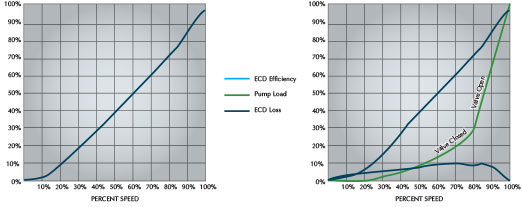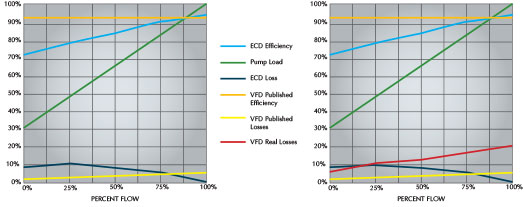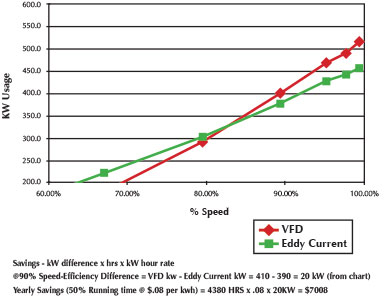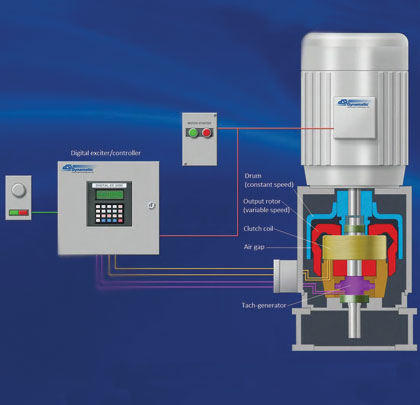Eddy current drives, known alternately as magnetic drives or eddy current couplings, have been a trusted and reliable means of controlling pump speed dating back to before World War II. They enjoyed a period of widespread growth in the municipal water and wastewater treatment industries during the two decades beginning about 1965. The Clean Water Act of 1972 fueled the expansion of wastewater treatment processing and supplied federal funding to municipalities facing new requirements for better levels of wastewater treatment. During this period, eddy current drives were routinely selected for variable speed pumping applications, such as raw water pumps, return- and waste-activated sludge pumps, effluent pumps, filter pumps, and various pumping stations where response to demand made variable speed the best choice for process and energy considerations.

Figure 2: Eddy current drive efficiency versus output speed
Figure 3: Eddy current drive losses when applied to a centrifugal pump
THE CASE FOR EDDY CURRENT DRIVES
An eddy current drive controls speed by regulating a DC excitation coil on a magnetic rotor, rotating concentrically with a steel drum, driven at by the motor at full speed, as illustrated in figure 1.
The “slip” between the input drum and the output rotor produces a “slip loss”, proportional to slip speed and the driven load. Thus, the efficiency of the drive, plotted as a function of speed, illustrates an approximate one-to-one relationship, as shown in figure 2.
Because a common reason for choosing variable speed is to reduce energy consumption, this efficiency performance may leave engineers and specifiers wanting something better. When variable frequency drives were developed and began to gain a foothold in the market, they boasted efficiency well in the 90s, across the entire speed spectrum. This promise of better efficiency fueled a shift in the market thought to justify preference of VFDs, even to the point of removing existing eddy current drives to achieve better energy performance.

Figure 4: Eddy current drive and VFD performance vs. percent flow
Figure 5: Comparing unreported VFD losses
CORRECTING MISPERCEPTIONS OF EDDY CURRENT DRIVES
However, a comparison of efficiency exaggerates the differences and ignores associated losses not considered in the calculation of VFD efficiency. It’s more instructive to examine the losses in a system, as this is a truer indication of energy consumption and associated electrical costs.
A variable speed pump behaves according to well-known “affinity laws,” such that the load bhp decreases in proportion to the speed reduction cubed. When applying the eddy current drive efficiency to a centrifugal pump load curve, the associated losses prove to be much lower than one might expect, as shown in figure 3.
Figure 3 also illustrates an often-overlooked fact: The pump only operates above the speed necessary to overcome static head and produce a useful flow. This is usually no lower than 75 percent of rated speed; in this example, 80 percent. If we expand the X-axis to include only the speed range from 80 percent and above, we can approximate the performance from zero to full flow, as in figure 4.
Figure 4 now includes published VFD efficiency and associated losses, in order to compare for those of eddy current drives. Note that while efficiency still appears to favor VFDs, the actual loss comparison is quite close. The eddy current drive actually exhibits less loss than the VFD above 90 percent flow.
However, most VFD installations include losses not considered in the efficiency calculation.
VFD input harmonic currents induce losses in feeders, transformers and harmonic mitigation devices often necessary for the safe operation of the VFD. These losses are usually impossible to quantify accurately, but result in marginally higher kilowatt-hour usage nonetheless.
In a similar manner, the output waveform of a VFD is not purely sinusoidal. This causes additional losses to appear in the motor, which must be supplied by the system. These losses are also very difficult to isolate and quantify, but are generally acknowledged to exist.
Many VFD installations require air conditioning or powered ventilation to provide adequate cooling to the VFD itself, which is sensitive to ambient temperature, due to the electronic nature of the equipment. In addition to the extra cost for this cooling equipment, the cost of powering the air conditioning is substantial. A rule of thumb holds that each 1 kilowatt of heat load requires 3 kilowatts of power.

ACCURATE COMPARISON AGAINST VFD DRIVES
When these additional losses are considered, the eddy current drive solution is as good or better than the VFD, as shown in figure 5.
These results have been demonstrated in actual installations. Figure 6 shows actual field results comparing eddy current drives and VFDs on identical pumps in the same application.
Most such comparisons will exhibit a crossover point where the VFD power consumption will exceed that of the eddy current drive. Experience has shown that above such a crossover speed, the eddy current drive uses less energy than the VFD. In the illustrated case, average speed of operation to be about 90 percent. Under this condition, the customer estimates saving $7000 per year in electrical costs.
LONG-LASTING, RELIABLE OPERATION
Eddy current drives are acknowledged to be unfailing workhorses in pumping applications. Many installations remain in service after nearly fifty years of continuous duty. Many others would probably still remain, had they not been replaced by VFDs, in a misguided quest for “better efficiency.”
_______________________________________________________________________
ABOUT THE AUTHOR
Gary Patterson is a water and wastewater specialist for Dynamatic® / Drive Source International, owner of the Dynamatic brand of eddy current adjustable speed drives, brakes, and controls. For more information, call 800.548.2169 or visit www.dynamatic.com.
_______________________________________________________________________
MODERN PUMPING TODAY, January 2014
Did you enjoy this article?
Subscribe to the FREE Digital Edition of Modern Pumping Today Magazine!



